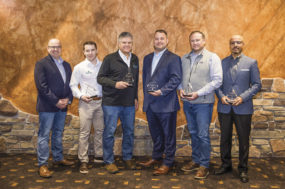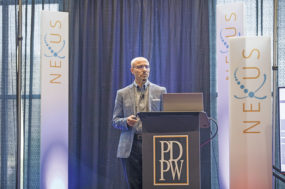Last spring we purchased a 9-month-old heifer, an unusual move for our farm. She was 200 GTPI points higher than anything tested in our herd, positive for all the traits we watch in genetic selection and comes from a cow family we really admire. She came from a farm nearby at a dispersal sale, and she sold at a price we felt was very reasonable given all of this.
Why IVF?
We talked about flushing her, but when it came down to it, we really just wanted to get her bred so that we could start milking her. After confirming her bred, though, we had second thoughts. We want to improve our herd, and we feel this heifer gives us an opportunity to accelerate that improvement.
We knew IVF (in vitro fertilization) was possible on pregnant animals, so we did a little research. It turned out that we didn’t have long to make the decision because we needed to start syncing recips (recipients) two days later. In the end, we compared the costs of IVF with the purchase of two or three replacement heifers of similar quality, and we decided to go for it. To ensure any pregnancies would result in heifers, we also elected to reverse sort the semen. For recips, we selected a handful of lower producing cows that have typically settled on first or second services and were open but far enough into their lactation for breeding. We also selected a few heifers, but we did not end up using them.
The process
The nearest facility is about a two-hour drive from our farm, across the state line, in Missouri. That facility does not perform all of the lab work, however; after the aspiration procedure, they send the oocytes to another facility in Texas. This also meant we had to send the semen for our mating to Texas. We were able to give all of the hormone shots on our farm, but the donor heifer had to be taken to Missouri to collect her oocytes, and the recips also had to make the trip for the embryo transfer.
The vet who performed the aspiration procedure let us watch and explained the process. It was really neat to see the ovaries and follicles via ultrasound. He also confirmed that she was carrying a bull calf despite breeding her with sexed semen (which reinforced our decision to reverse sort).
The results
They counted oocytes in the lab before we left the facility. She had made 30, which we were told was a very good number, especially for a heifer. We were also told that typically 20 to 30 percent of those would likely turn into embryos. We headed home very optimistic about the number of embryos we would be implanting the following week. Unfortunately, the news was not so good when that time came. Half of the oocytes had fertilized, but only two had continued to develop. There was no identifiable reason; they just didn’t develop. The two that we got were high quality, though, and they were implanted fresh. We blood tested the recips about 45 days after aspiration, and one of the two is pregnant.
Would we do it again?
I think this is the true test of the experience. In all honesty, we will likely try a conventional flush before we will try IVF again. The costs were quite a bit higher, and doing so much of the work off-farm was a hassle. That said, one embryo is a bit of a disappointment, but I’m confident that one is better that none. Especially considering that the heifer is carrying a bull calf herself, I think we will be ecstatic if that embryo results in a heifer. PD

-
Jennifer Heim
- Dairy Producer and Engineer
- Heim Dairy
- Email Jennifer Heim





